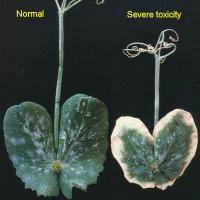Diagnosing boron toxicity in field peas
White seed peas are susceptible to boron toxicity, but the brown-seeded Dun type grown in Wetern Australia is rarely affected.
What to look for
- Plants with marginally pale to marginally scorched older leaves in spring, particularly in seasons when subsoil moisture is important for the plant to mature.
- Symptoms will vary with soil type, and be worse on highly alkaline clay soils with high levels of subsoil B.
Paddock
- Early symptoms occur on middle leaves as pale yellow to orange chlorosis. Tendrils are excessively curled.
- Symptoms then occur on older leaves as marginal chlorosis containing pink spots.
- The spots join causing death of the leaf margin.
Plant
What else could it be
| Condition | Similarities | Differences |
|---|---|---|
| Diagnosing zinc deficiency in field peas | Pale marginally necrotic old leaves | Symptoms appear in early rather than early growth stage; small cupped new leaves and shortened internodes. |
| Diagnosing group C herbicide damage in field peas | Older leaf pale necrosis. | Affects seedlings |
| Diagnosing potassium deficiency in field peas | Older leaf pale necrosis | Pinkish necrotic spots rather than marginal necrosis; potassium deficiency is not an issue on heavy alkaline soils. |
| Diagnosing soil acidity in field peas | Older leaf pale necrosis | Necrotic leaf patches rather than margins, stunted roots, mainly lighter textured soils. |
Where does it occur?

Soil type
- Boron toxicity is an inherent characteristic of some soils especially those formed from marine or wind-blown sediments that have an alkaline sodic subsoil. In WA, boron toxicity occurs most commonly in the mallee area north of Esperance, and on morrel soils around the south eastern lakes area and the eastern wheatbelt.
- Boron toxicity is more prevalent in dry seasons and in years with mid-season drought when crops rely on deep subsoil moisture.
- Boron is more likely to be a problem when it is present closer to the soil surface, where roots encounter high levels of boron in the early stages of development or as seedlings.
- Boron toxicity may be caused by adding boron-rich subsoil to non-wetting sandy topsoils as occurs with claying, but this is unlikely to remain an ongoing problem.
Management strategies
- It is not economically viable to treat boron toxicity in broadacre cropping systems and the constraint is best overcome by growing brown rather than white seeded peas.
How can it be monitored?
- Identifying boron toxicity using tissue testing is difficult due to the uneven distribution of boron throughout the plant.
- The standard laboratory method for extracting boron from soils using hot calcium chloride solution provides an accurate reflection of the soil boron level in the sample. However, standard topsoil testing is unreliable because boron levels increase with depth, and boron levels can vary widely across the soil.
See also
Further information
Where to go for expert help
Page last updated: Wednesday, 13 May 2015 - 1:39pm




